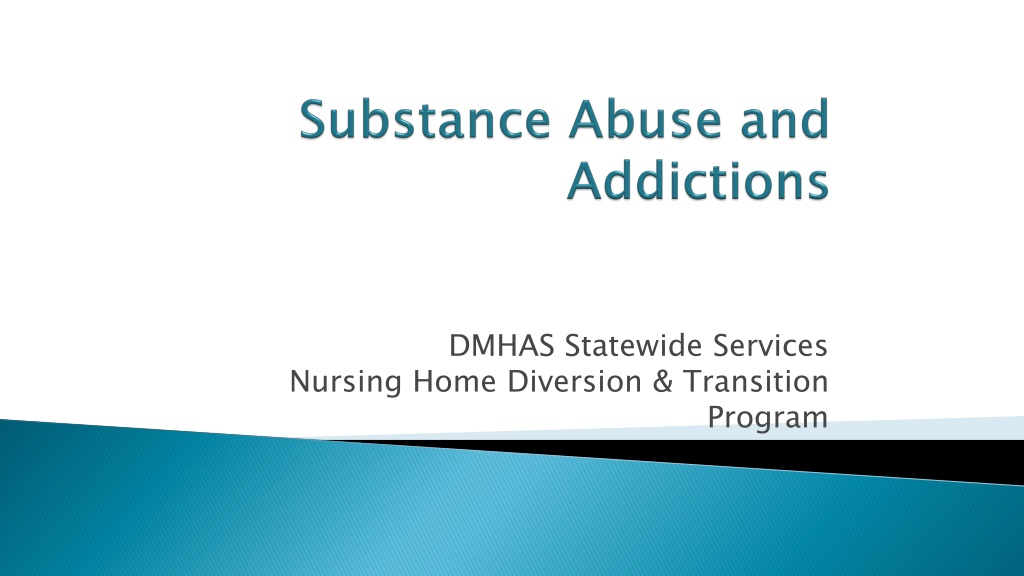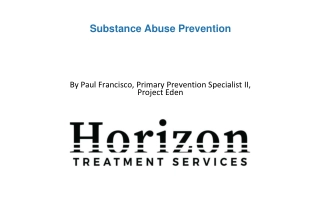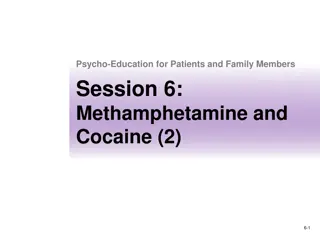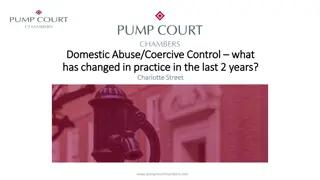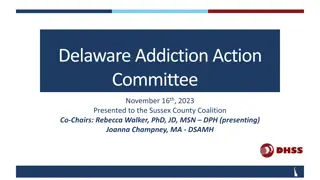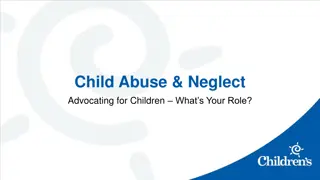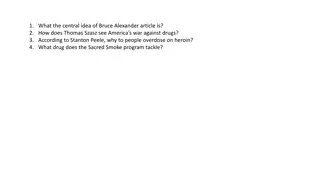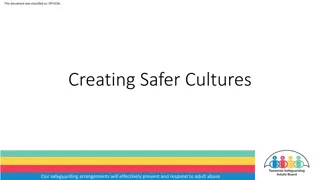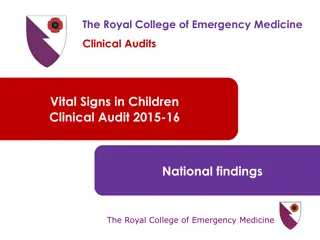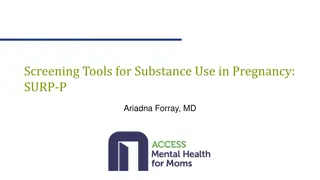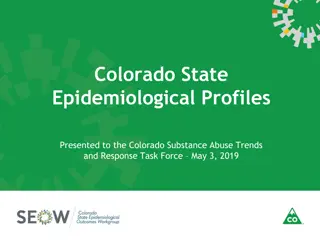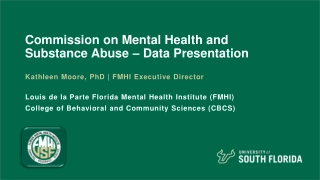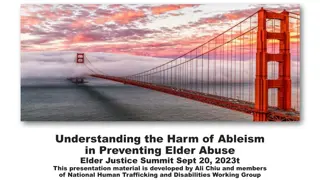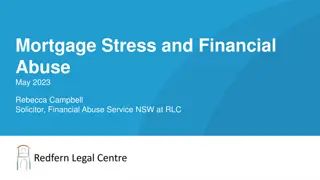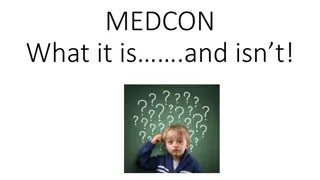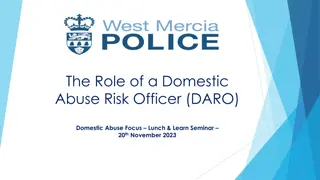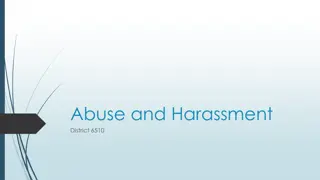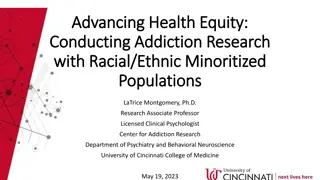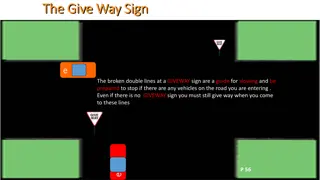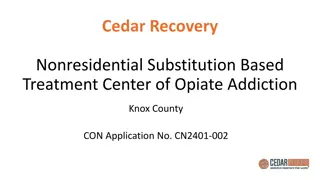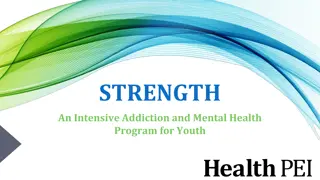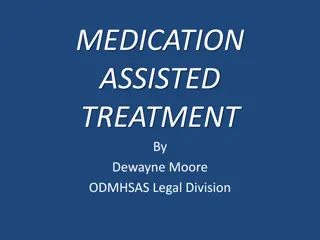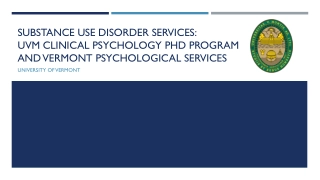Understanding Substance Abuse and Addiction Signs
Substance abuse is characterized by harmful substance use with significant impairment, while addiction is a disease where individuals cannot stop using despite harm. Signs include changes in behavior, lack of interest in previous activities, problems at work or with relationships, increased tolerance, and physical symptoms like red eyes and shaking.
Download Presentation

Please find below an Image/Link to download the presentation.
The content on the website is provided AS IS for your information and personal use only. It may not be sold, licensed, or shared on other websites without obtaining consent from the author. Download presentation by click this link. If you encounter any issues during the download, it is possible that the publisher has removed the file from their server.
E N D
Presentation Transcript
DMHAS Statewide Services Nursing Home Diversion & Transition Program
Pattern of harmful use of a substance with the purpose of altering one s mood Using substances in a manner that is not prescribed or intended Repeated use that causes significant impairment such as: Health issues, Disabilities Failure to meet responsibilities Impaired control, Risky use Negatively impacts relationships 2
Substance abuse differs from addiction Substance abusers can quit or change their behavior Addiction is a disease An addicted person cannot stop using, even when the condition causes harm. 3
Lack of interest in things one used to love Changing friends often Stop taking care of self Spending more time alone Eating more/less than usual Sleeping at odd hours 4
Problems at work or with relationships Quick mood changes Leaving empty bottles, nips, paraphernalia Financial fallout stealing, unpaid bills, money or family valuables go missing, chronic lying Car accidents/fender benders Legal issues 5
Using on a regular or more frequent basis Increased tolerance for the substance Failed attempts at stopping use Beginning to develop psychological and/or physical need Increased unpredictability 6
Red or glassy eyes, runny nose General personality changes Memory and concentration loss Lack of motivation Lowered inhibitions 7
Glassy, red eyes Slurred speech Difficulty walking Shakiness, tremors Inability to focus Loud volume Decreased inhibitions Sweating 8
Stage 1 5 5- -8 hours after last drink Anxiety, Restlessness Mild nausea, Lack of appetite, Insomnia, Sweatiness, Mild tremors, Racing heart beat, Raised blood pressure, Mild cognitive impairments. Headache Stage 1 8 hours after last drink 9
Stage 2, 24 Increased restlessness, Agitation Increased tremors, Hallucinations Disorientation, Nausea, Vomiting, Diarrhea, Heart rate greater than 120, Seizures (grand mal). Stage 2, 24- -72 hours after last drink 72 hours after last drink 10
Stage 3 72 to 96 hours after last drink the DT s. Fever Very high blood pressure, Very fast heart rate Delirium, Drenching sweats, Severe tremors Death can occur at this stage Seek medical attention immediately Hallucinations Stage 3 72 to 96 hours after last drink - - also known as the DT s. also known as 11
Aspirin Acetaminophen Cold & allergy medications Cough syrup Sleeping pills Pain medication, including opioids Antidepressants and anti-anxiety meds 12
Retirement-Loss of identity, Loss of purpose Death of a family member, Spouse, Pet, Friend Change of Residence Trouble sleeping can lead to inappropriate medication use Post surgery, Hip/Knee replacement Mental/Physical health decline Increased isolation Family conflict Relocation 13
Slurred speech, Dizziness, Difficulty walking, and Confusion can all be found in: Diabetes Epilepsy Parkinson s Multiple Sclerosis Dementia Infections 14
Send out to Hospital Report to Treatment Team Rule out medical conditions Suggest Inpatient treatment, CCAR, AA meetings Conduct a toxicology screen Follow your facility s policy/procedures Stay with the resident until medically cleared Narcan(for Opiate overdose-keep a supply ) 15
Severe cravings and compulsive substance abuse despite harmful consequences Intense focus on using certain substances to the point that it takes over one s life Loss of control over the amount and frequency of use 16
Continued use in the face of adverse or negative consequences Changes in the wiring of the brain which causes intense cravings 17
Brain imaging shows changes in brain functioning that relate to: Judgement Decision making Learning Memory Behavioral control Brain imaging shows changes in brain functioning that relate to: Addiction can run in families; 50%-60% of addiction can be related to family genetics 18
Addiction is progressive Physical tolerance increases along with the psychological need and cravings for the substance Addiction is progressive Irritability Inability to deal with stress Rationalizing Minimizing, Blaming, Defending Inability to accept responsibility 19
Alcohol Nicotine/Tobacco/Caffeine Opioids/Pain Medications/Cocaine/Speed (methamphetamines), Heroin, Benzos, etc. Over the Counter medications (cough medicine, Sudafed) 20
Gambling Internet/Cell phone/Gaming Pornography/Sex Food/Sugar Shopping 21
Mood swings, Irritability Multiple unsuccessful attempts to stop or limit use Excessive time spent obtaining, using, and/or thinking about the substance Withdrawal from usual activities- Socializing and Family relationships Toxic relationships with other users 22
Stealing money, Prescriptions or Alcohol from others, lying Physical changes in appearance, Poor hygiene, Poor dental hygiene (losing teeth) Sweats, Fever, Chills, Nausea, Vomiting, Depression, Diarrhea 23
Financial trouble Passing bad checks Excessive ATM withdrawals, overdrawing bank accounts Selling/trading prized possessions Financial trouble- - 24
Weakness Blurred vision Drowsiness Blacking out Memory lapse Asking others for pills Doctor shopping- to obtain multiple prescriptions Going through others medicine cabinets Inability to stop using despite attempts Poor judgement Passing out 25
Xanax Klonopin Librium Ativan Valium Restoril Halcion 26
Mood Changes Mixing Benzos with other drugs Engaging in risky behaviors Impaired coordination Withdrawal Symptoms 27
Problems concentrating Sleep disturbance Irritability Increased anxiety Panic Attacks Hand tremors Dry heaving/Vomiting Heart Palpitations Headaches Muscle pain/Stiffness Withdrawal symptoms can be dangerous, and may result in seizures, coma, and even death Withdrawal symptoms can be dangerous, and may result in seizures, coma, and even death 28
Nausea/Vomiting Unconsciousness or intermittent loss of consciousness Labored breathing Constricted pupils Shallow or Restricted breathing Bluish lips and fingertips Extreme sleepiness or Inability to waken Clammy skin Confusion 29
Heroin Morphine Fentanyl Hydrocodone Methadone Percocet Oxycodone Dilaudid 30
Chronic overuse of Opiates can cause severe and long lasting complications to the body, such as: Heart complications like a decreased heart rate or cardiac arrest Respiratory complications like shallow breathing or depressed respirations Unconsciousness Increased risk of addiction Overdose 31
Call 911, Stay on the phone Begin Rescue Breathing Administer Narcan Nasal Spray, if available (often takes more than one Stay with the person, Roll onto their side to prevent vomiting and choking often takes more than one) 32
BEWARE Of Prescribed Prescribed MEDICATIONS MEDICATIONS that can BE Used in the Addiction Cycle 33
Over-the-counter and prescription drugs can help and heal us- Besides marijuana- legal medicines commonly abused drugs in the U.S. legal medicines are the most commonly abused drugs in the U.S. are the most But some can be addictive and dangerous if they re used the wrong way. Drug abuse isn't just about street drugs Drug abuse isn't just about street drugs 34
Adderall ADHD Adderall- - can help people with A common ingredient in over and cough medicines helps stop the cough A common ingredient in over- -the and cough medicines- - the- -counter cold counter cold But some people use amphetamines to get high, to boost energy and alertness, or to keep their weight down But large doses can get you high and cause hallucinations You can get addicted to these stimulants It's popular- since cough syrup is so easy to find in medicine cabinets 35
Pseudoephedrine Pseudoephedrine This is a decongestant in lots of non- prescription cold medicines. While it helps clear up a stuffy nose, it's also an ingredient in illegal methamphetamine ("meth"). 36
Some of the most commonly abused prescription meds are painkillers - specifically, opioids. These drugs dull pain, but in large doses they can also cause a euphoric high and have dangerous side effects. 37
Bupropion HCL- commonly known as Wellbutrin with depression, anxiety, and seasonal affective disorder and to reduce smoking- among other conditions. Wellbutrin-is prescribed by doctors to patients It has also been aptly named-the Poor Man s Cocaine - Because it elicits stimulant effects to cocaine and crack It s one of the more popular and easily accessible prescription drugs It s one of the more popular and easily accessible prescription drugs. 38
Drowsiness Confusion Unsteady walking Slurred speech Poor concentration Dizziness Problems with memory Slowed breathing Constipation Nausea Feeling high Slowed breathing rate Drowsiness Confusion Poor coordination Increased dose needed for pain relief Opioids Anti Anti- -anxiety medicines and sedatives anxiety medicines and sedatives 39
Stealing or selling prescriptions Taking higher doses than prescribed Being hostile or having mood swings Sleeping less or more Making poor decisions Being unusually energetic, high or revved up Being drowsy Trying to get prescriptions from more than one prescriber Increased alertness Feeling high Irregular heartbeat High blood pressure High body temperature Reduced appetite Insomnia Agitation Anxiety Paranoia Stimulants Stimulants Other signs Other signs 40
Addiction is an inability to stop. Addiction includes a psychological hold on the person that is the result of continuous substance use. This results in behavioral disturbances such as stealing, lying, etc. Addiction is an inability to stop. Dependence is physical the substance, requiring more and more as tolerance increases. May not include behavioral disturbances of stealing, lying, etc. Dependence is physical- - the body adapts to 41
You can have dependence without addiction. For example, someone who is dependent on pain killers is not necessarily addicted to them. However, someone who is addicted has some level of physical dependence as well. 42
There are no normal or standardized time frames to recovery, everyone s recovery is different. Recovery is a lifetime commitment. If relapse happens it should be viewed as an opportunity to bolster one s commitment to recovery 43
It is important to uncover for the relapse. If relapse occurs, the introduction of a new tool or strategy can help make another relapse less likely. People are more successful in recovery when they feel supported by their community, family & friends uncover the reason 44
2021 WebMD, LLC. 2021 AspenRidge Recovery | Colorado Mental Health and Addiction Treatment Center. | 45
